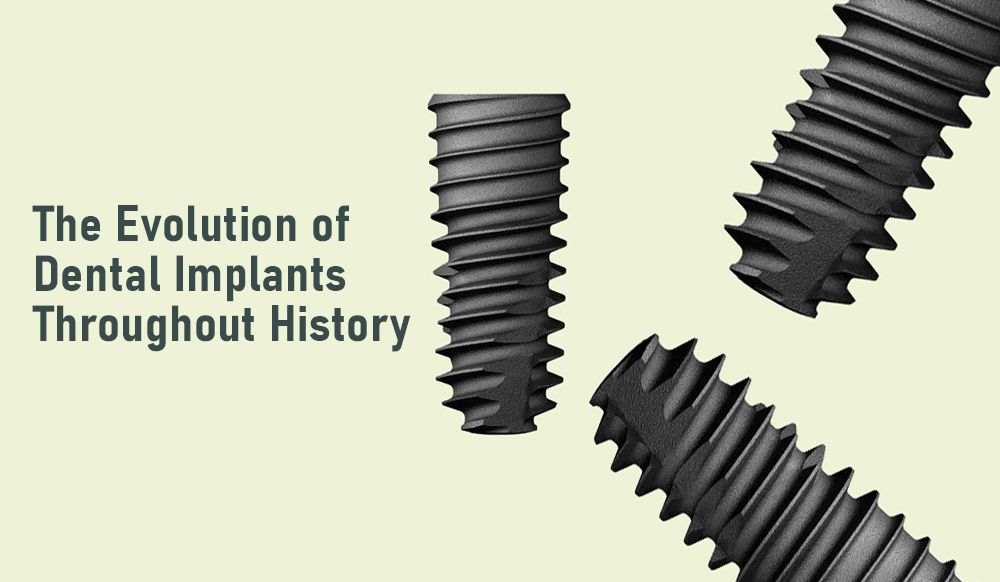It may come as a surprise to you, but dental implants have been around for centuries. In fact, the earliest dental implants date back to A.D. 600.
However, they have advanced over the years. If you’re thinking of getting a dental implant today, you should be thankful — you’ll experience a safe experience with minimal discomfort. Most of the original practices, however, were barbaric, painful and sometimes fatal.
Here’s a look at the historical background and evolution of dental implants.
Implants in Antiquity
Implants date as far back as 4,000 years ago when bamboo pegs were carved in China and used to replace missing teeth. These were fixed onto the bone in the mouth. Around 2000 years later, the Egyptians adopted a similar practice of carving precious metals and pegging them onto the jawbone. Archeologists have also found numerous skulls with artificial and transplanted teeth made from elephant ivory.
In 1931, Wilson Popenoe, together with his wife, found the skull of a young woman in Honduras. Her lower jaw had three missing teeth which had been replaced by shells. The shells had been shaped to mimic the structure of the teeth. Bone growth and calculus were present, so these teeth were made for function and not aesthetics.
Today, modern technology has made dental implants the go-to solution for missing teeth.
How Have Dental Implants Changed Over Time?
In the 18th century, researchers used a blend of gold and alloy to create dental implants. Unfortunately, these experiments were a massive failure, but they opened doors to more fruitful research in later years.
In the 1800s, dental professionals experimented with numerous materials, including silver and porcelain. One doctor used a porcelain implant that had a platinum disc. However, these efforts were unsuccessful because the bone rejected all the materials they used. A successful implant involves permanently fusing an implant into the jawbone.
Throughout the 1900s, many doctors tried different materials, but none of them provided long-term results. In 1913, Dr. Greenfield tried to use 24-karat gold as an implant. Then, two brothers, Drs. Alvin and Moses, tried to use fixtures made from Vitallium after observing the material being used in hip bone implants. These fixtures were more long-lasting, and the brothers were recognized as the first people to place an implant into the jawbone successfully.
When Did Dental Implants Become Popular?
In 1952, Dr. Per-Ingvar Brånemark laid the foundation for modern-day dental implants when he accidentally discovered that implants made from titanium had a better success rate. He implanted a piece of titanium onto a rabbit’s femur and was not able to remove it because the titanium had fused with the bone.
After further experimentation, he used titanium to replace a missing tooth in one of his patients, and it was a success. This was a significant breakthrough in the dental implant industry. He went on to publish several studies explaining the benefits of using titanium in dental implants. Thanks to Dr. Per-Ingvar Brånemark, dental implants have improved over the years to become what they are today.
Present Day Implants
Since Dr. Per-Ingvar Brånemark’s discovery, titanium has been used to make dental implants. Over seven million implants from the Brånemark System have been transplanted, on top of millions of other implants from newer companies.
Dental implants continue to be manufactured from high-grade titanium and shaped so that they can be securely fixed to the jawbone. Though this method has a few risks, it’s still the best and most successful method of affixing implants.
Modern Dental Implants and High Success Rates
Today’s implants have an extremely low failure rate. Current implants come in a variety of shapes and sizes to suit different teeth. Their surfaces have been created to enhance seamless integration. Instead of being straight and smooth, they’re roughened to increase the surface area where the bone can become attached.
Together with proper treatment, sound surgical procedure, and prosthetics that account for bone density, health, function, speech, aesthetics, and ease of cleaning, you can expect up to 10-year success rates in over 98% of cases.
In contrast, bridges, crowns, and root canals only have a 10-year success rate in about 80% of cases. In fact, almost all medical surgeries have a 10-year success rate of only 75%. In short, dental implant surgery has become extremely successful and predictable.
How to Find a Quality Dental Implant You Can Trust
One of the best ways to reduce implant failure is by working with a professional dentist who uses quality dental implants. Hiossen® Implant pays close attention to every detail, from diagnosis and treatment to the evaluation of your bone health and integration of the implant. We always take extra care to ensure the success of your dental implant surgery. Please give us a call or reach out to us online if you need more information.

